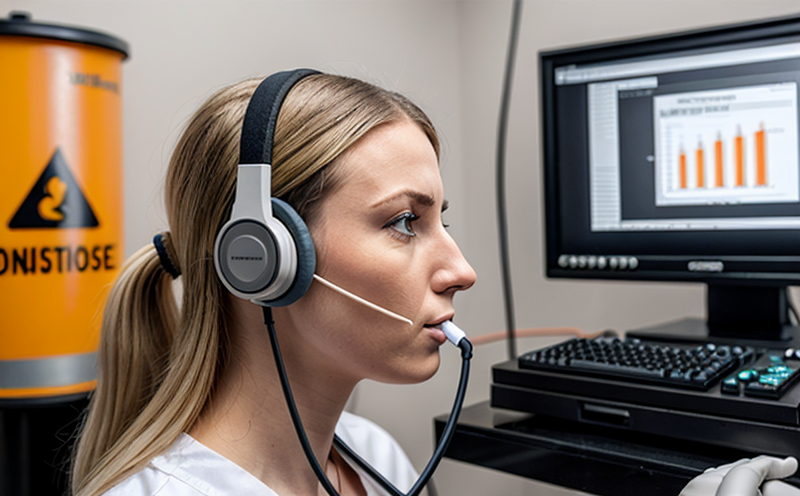ANSI S12.71 Field Performance of Hearing Protectors Testing
The ANSI S12.71 standard is a crucial tool in ensuring that hearing protection devices (HPDs) perform effectively under real-world conditions. This service focuses on the rigorous testing required to validate HPD performance according to this standard, which is widely used by industries where occupational noise exposure is a concern.
The ANSI S12.71 test evaluates how well a hearing protector attenuates sound in various field conditions, ensuring that it meets specified performance criteria under actual work environments. This service is particularly important for quality managers, compliance officers, and R&D engineers who need to verify the effectiveness of their HPDs before deployment.
The testing process involves several steps to ensure accuracy and reliability. First, the HPD must be properly fitted to the subject. Proper fitting is critical because even a small gap can significantly reduce the protector's performance. The test then proceeds with the subject performing tasks that simulate real-world noise exposure scenarios. This ensures that the hearing protection provided under these conditions meets the required attenuation levels.
The testing apparatus used includes sound generators, dosimeters to measure noise exposure, and HPD fitting tools. These instruments are calibrated according to international standards (ISO 1999:2007) to ensure consistent and accurate measurements. The results of this evaluation provide a comprehensive understanding of the protector's performance in terms of attenuation levels across different frequencies.
The acceptance criteria for ANSI S12.71 are stringent, ensuring that HPDs meet or exceed specified performance thresholds. Compliance with these standards is essential because they help protect workers from noise-induced hearing loss and other associated health risks. The standard also considers the comfort and usability of the protector to ensure it can be worn continuously during work shifts.
The testing process involves multiple iterations to refine and validate the HPD's performance under various conditions. This iterative approach ensures that any discrepancies or issues are identified and addressed, leading to more reliable and effective protection devices. The final report provides detailed insights into the protector's performance, including attenuation levels, comfort ratings, and fit factors.
The importance of ANSI S12.71 in occupational safety cannot be overstated. By ensuring that HPDs perform effectively under real-world conditions, this standard helps protect workers from noise-induced hearing loss and other health risks associated with prolonged exposure to loud noises. The service provided by our laboratory ensures that these devices meet the highest standards of performance and reliability.
Applied Standards
The ANSI S12.71 standard is complemented by several other international standards that contribute to a comprehensive approach to occupational noise exposure and hearing protection. These include:
- ISO 1999:2007: This standard provides guidelines for the measurement of sound levels in the workplace, which are crucial for accurate dosimetry.
- ASTM E358-14: This test method specifies procedures for determining the attenuation and insertion loss of hearing protectors, ensuring consistent performance metrics.
- EN 375:2016: This European standard sets out requirements for ear protectors with electronic sound amplification circuits, ensuring safety in noise environments where natural sounds need to be enhanced without compromising protection.
The use of these standards ensures that the testing process is both accurate and consistent across different laboratories, providing reliable data that can be trusted by industry stakeholders. Compliance with these standards also helps ensure that HPDs meet regulatory requirements and provide effective protection in real-world conditions.
Scope and Methodology
The scope of ANSI S12.71 Field Performance of Hearing Protectors Testing is to evaluate the effectiveness of hearing protectors under field conditions, ensuring they meet specified performance criteria according to this standard. The methodology involves several key steps:
- Subject Preparation: Subjects undergo a fitting test to ensure proper HPD placement.
- Noise Exposure Simulation: The subject performs tasks simulating real-world noise exposure scenarios.
- Data Collection: Sound levels are measured using dosimeters, and HPD performance is recorded.
- Analysis: Data from the tests are analyzed to determine compliance with ANSI S12.71 requirements.
The testing process is designed to simulate real-world conditions as closely as possible, ensuring that the results accurately reflect how the protector will perform in actual use. This approach provides valuable insights into the protector's performance, enabling informed decisions about its suitability for specific work environments.
The methodology used by our laboratory adheres strictly to ANSI S12.71 and other relevant standards, ensuring accurate and reliable test results. The use of calibrated instruments and standardized procedures ensures consistency and accuracy in the testing process. Our team of experts is well-versed in these methodologies, providing clients with confidence in the validity of their test results.
Use Cases and Application Examples
The ANSI S12.71 Field Performance of Hearing Protectors Testing has numerous applications across various industries where occupational noise exposure is a concern. Here are some specific use cases:
- Construction Industry: Construction workers often face high levels of noise from machinery and equipment, making HPD testing essential to ensure compliance with safety regulations.
- Mining Operations: Miners exposed to constant loud noises need effective protection, which can be validated through ANSI S12.71 testing.
- Agricultural Workers: Agricultural operations involve machinery and animals that generate significant noise levels, necessitating proper HPD evaluation.
- Manufacturing Plants: Workers in manufacturing environments benefit from HPD testing to ensure they are protected against excessive noise exposure.
- Hospitality Industry: Staff working in noisy environments like restaurants and bars require effective HPDs to protect their hearing.
In each of these industries, ANSI S12.71 testing ensures that the HPD used meets the necessary performance criteria under real-world conditions. This is particularly important for workers whose job roles involve prolonged exposure to loud noises. The test results provide valuable insights into the protector's effectiveness and help inform decisions about its suitability for specific work environments.
The use cases highlighted above demonstrate the versatility of ANSI S12.71 testing in various industries, ensuring that workers are protected against noise-induced hearing loss and other associated health risks. This service is essential for maintaining a safe and healthy working environment by providing reliable data on HPD performance.





